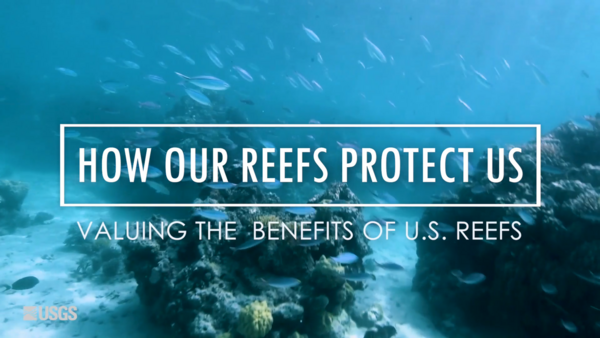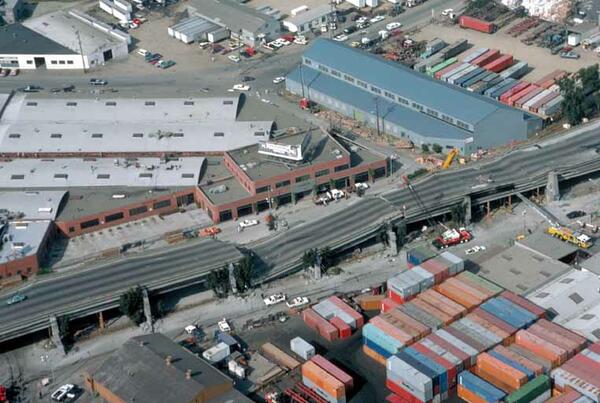This video demonstrates a simulation of how storms can impact sandy coastlines through processes such as erosion. This demonstration is conducted at outreach events by scientists at the St. Petersburg Coastal and Marine Science Center. The activity can also be re-created at home or in the classroom.
Videos
Explore a wide variety of videos that highlight natural hazards, the risks they pose and the science we conduct to better understand and prepare for them.
Explore Earthquake Preparedness Videos
Earthquake hazards are a national risk, with nearly half of Americans living in areas prone to potentially damaging earthquakes. Learn about tools and resources that can help us all be better prepared.
This video demonstrates a simulation of how storms can impact sandy coastlines through processes such as erosion. This demonstration is conducted at outreach events by scientists at the St. Petersburg Coastal and Marine Science Center. The activity can also be re-created at home or in the classroom.
 Yellowstone Volcano Observatory Monthly Update: February 3, 2020
Yellowstone Volcano Observatory Monthly Update: February 3, 2020
Mike Poland, Scientist-in-Charge of the Yellowstone Volcano Observatory, gives an overview of activity at Yellowstone during January 2020.
Mike Poland, Scientist-in-Charge of the Yellowstone Volcano Observatory, gives an overview of activity at Yellowstone during January 2020.
 What will you do when Earth’s largest active volcano erupts?
What will you do when Earth’s largest active volcano erupts?
In 2019, the Volcano Alert Level for Mauna Loa was elevated from “NORMAL” to “ADVISORY” due to increased seismicity and deformation at the volcano. This alert level does not mean an eruption is imminent, but it is a fact that Mauna Loa, which has erupted 33 times since 1843 (most recently in 1984), will erupt again. What will you do when it does?
In 2019, the Volcano Alert Level for Mauna Loa was elevated from “NORMAL” to “ADVISORY” due to increased seismicity and deformation at the volcano. This alert level does not mean an eruption is imminent, but it is a fact that Mauna Loa, which has erupted 33 times since 1843 (most recently in 1984), will erupt again. What will you do when it does?
The 2018 Kīlauea eruption produced unprecedented levels of seismicity in the volcano’s instrumented history. The USGS Hawaiian Volcano Observatory documented about 80,000 earthquakes during the three-month-long eruption, starting with the dramatic collapse of the Puʻu ʻŌʻō cone on April 30 and ending with the final Kīlauea summit caldera collapse event on August 5.
The 2018 Kīlauea eruption produced unprecedented levels of seismicity in the volcano’s instrumented history. The USGS Hawaiian Volcano Observatory documented about 80,000 earthquakes during the three-month-long eruption, starting with the dramatic collapse of the Puʻu ʻŌʻō cone on April 30 and ending with the final Kīlauea summit caldera collapse event on August 5.
 Kīlauea Lower East Rift Zone 2019: Quiet but insightful
Kīlauea Lower East Rift Zone 2019: Quiet but insightful
In the year since Kīlauea Volcano’s notable 2018 eruption ended, the lower East Rift Zone has been relatively quiet. But USGS Hawaiian Volcano Observatory scientists continue to gain insight into the eruption through ongoing research and monitoring. Some of the many questions asked by island residents include, Why did the fissures erupt along a linear pattern?
In the year since Kīlauea Volcano’s notable 2018 eruption ended, the lower East Rift Zone has been relatively quiet. But USGS Hawaiian Volcano Observatory scientists continue to gain insight into the eruption through ongoing research and monitoring. Some of the many questions asked by island residents include, Why did the fissures erupt along a linear pattern?
 Mapping the Ground Failure—Puerto Rico Post-Dec 28, 2019 Quake
Mapping the Ground Failure—Puerto Rico Post-Dec 28, 2019 Quake
My name is Kate Allstadt. I’m a research geophysicist with the U.S.
My name is Kate Allstadt. I’m a research geophysicist with the U.S.
 What can lava tell us? Deciphering Kīlauea’s 2018 eruption
What can lava tell us? Deciphering Kīlauea’s 2018 eruption
The 2018 eruption on Kīlauea’s lower East Rift Zone spewed around a billion cubic yards of lava into Puna. From the moment the eruption began, samples of lava were collected and rapidly analyzed by a team of USGS Hawaiian Volcano Observatory and University of Hawaiʻi at Hilo scientists.
The 2018 eruption on Kīlauea’s lower East Rift Zone spewed around a billion cubic yards of lava into Puna. From the moment the eruption began, samples of lava were collected and rapidly analyzed by a team of USGS Hawaiian Volcano Observatory and University of Hawaiʻi at Hilo scientists.
Kīlauea Volcano's summit has been in an eruptive pause since the 2018 events ended over a year ago. Nevertheless, it remains a dynamic place. Ongoing inflation and seismicity indicate that the summit magma chamber is gradually recharging.
Kīlauea Volcano's summit has been in an eruptive pause since the 2018 events ended over a year ago. Nevertheless, it remains a dynamic place. Ongoing inflation and seismicity indicate that the summit magma chamber is gradually recharging.
 Puerto Rico 2020 — Temporary Seismic Stations Post-Dec 28, 2019 Quake
Puerto Rico 2020 — Temporary Seismic Stations Post-Dec 28, 2019 Quake
Dr. Elizabeth Vanacore talks about the installation of temporary seismic stations in southwest Puerto Rico.
Dr. Elizabeth Vanacore talks about the installation of temporary seismic stations in southwest Puerto Rico.
Tens of thousands of earthquakes occur each year in Hawaii, making it one of the most seismically active places in the United States.
Tens of thousands of earthquakes occur each year in Hawaii, making it one of the most seismically active places in the United States.
 Transitions: What's next for HVO and the volcanoes it monitors?
Transitions: What's next for HVO and the volcanoes it monitors?
2018 and 2019 were years of profound change at Kīlauea Volcano and the USGS Hawaiian Volcano Observatory. Devastation caused by the largest lower East Rift Zone eruption and summit collapse in at least 200 years resulted in many transitions for island residents, including HVO.
2018 and 2019 were years of profound change at Kīlauea Volcano and the USGS Hawaiian Volcano Observatory. Devastation caused by the largest lower East Rift Zone eruption and summit collapse in at least 200 years resulted in many transitions for island residents, including HVO.
 How Our Reefs Protect Us: Valuing the Benefits of U.S. Reefs
How Our Reefs Protect Us: Valuing the Benefits of U.S. Reefs
The degradation of coastal habitats, particularly coral reefs, raises risks by increasing the exposure of coastal communities to flooding hazards during storms. The protective services of these natural defenses are not assessed in the same rigorous economic terms as artificial defenses, such as seawalls, and therefore often are not considered in decision-making.
The degradation of coastal habitats, particularly coral reefs, raises risks by increasing the exposure of coastal communities to flooding hazards during storms. The protective services of these natural defenses are not assessed in the same rigorous economic terms as artificial defenses, such as seawalls, and therefore often are not considered in decision-making.
 Yellowstone Volcano Observatory Monthly Update: January 2, 2020
Yellowstone Volcano Observatory Monthly Update: January 2, 2020
Mike Poland, Scientist-in-Charge of the Yellowstone Volcano Observatory, gives an overview of activity at Yellowstone during 2019, with an emphasis on the month of December.
Mike Poland, Scientist-in-Charge of the Yellowstone Volcano Observatory, gives an overview of activity at Yellowstone during 2019, with an emphasis on the month of December.
 How Our Reefs Protect Us: Valuing the Benefits of U.S. Reefs (AD)
How Our Reefs Protect Us: Valuing the Benefits of U.S. Reefs (AD)
The degradation of coastal habitats, particularly coral reefs, raises risks by increasing the exposure of coastal communities to flooding hazards during storms. The protective services of these natural defenses are not assessed in the same rigorous economic terms as artificial defenses, such as seawalls, and therefore often are not considered in decision-making.
The degradation of coastal habitats, particularly coral reefs, raises risks by increasing the exposure of coastal communities to flooding hazards during storms. The protective services of these natural defenses are not assessed in the same rigorous economic terms as artificial defenses, such as seawalls, and therefore often are not considered in decision-making.
 Yellowstone Volcano Observatory Monthly Update: December 2, 2019
Yellowstone Volcano Observatory Monthly Update: December 2, 2019
Mike Poland, Scientist-in-Charge of the Yellowstone Volcano Observatory, describes activity at Yellowstone during the month of November 2019.
Mike Poland, Scientist-in-Charge of the Yellowstone Volcano Observatory, describes activity at Yellowstone during the month of November 2019.
 Sampling the water in Halema‘uma‘u - Kīlauea Volcano
Sampling the water in Halema‘uma‘u - Kīlauea Volcano
USGS Hawaiian Volcano Observatory scientists Frank Younger and Patricia Nadeau talk about sampling the water at the bottom of Halemaʻumaʻu, a crater at the summit of Kīlauea Volcano. The water appeared in July 2019 and has steadily risen since then.
USGS Hawaiian Volcano Observatory scientists Frank Younger and Patricia Nadeau talk about sampling the water at the bottom of Halemaʻumaʻu, a crater at the summit of Kīlauea Volcano. The water appeared in July 2019 and has steadily risen since then.
 PubTalk 11/2019 —Sea-Level Rise, Extreme Water Levels, Coastal Erosion
PubTalk 11/2019 —Sea-Level Rise, Extreme Water Levels, Coastal Erosion
Title: Sea-Level Rise, Extreme Water Levels, and Coastal Erosion ... How bad could it possibly be?
Title: Sea-Level Rise, Extreme Water Levels, and Coastal Erosion ... How bad could it possibly be?
 Yellowstone Volcano Observatory Monthly Update: November 1, 2019
Yellowstone Volcano Observatory Monthly Update: November 1, 2019
Mike Poland, Scientist-in-Charge of the Yellowstone Volcano Observatory, describes activity at Yellowstone during the month of October 2019
Mike Poland, Scientist-in-Charge of the Yellowstone Volcano Observatory, describes activity at Yellowstone during the month of October 2019
 Animation depicting seasonal cycles on Alaska's Arctic bluffs
Animation depicting seasonal cycles on Alaska's Arctic bluffs
In the spring, winter sea ice thaws and moves offshore leaving the coast exposed to increased wave action and relatively warm water temperatures that, when in contact with the bluff, erodes the toe of the bluff.
In the spring, winter sea ice thaws and moves offshore leaving the coast exposed to increased wave action and relatively warm water temperatures that, when in contact with the bluff, erodes the toe of the bluff.
 Initial Observations of Cypress Structure Collapse, Oakland, CA 1989
Initial Observations of Cypress Structure Collapse, Oakland, CA 1989
Retrospective interview with USGS Geophysicist Susan Hough about the collapse of the Nimitz Freeway (known as the Cypress Structure) in Oakland, CA, during the October 17, 1989 Loma Prieta Earthquake and how the first responders reacted to the event.
Retrospective interview with USGS Geophysicist Susan Hough about the collapse of the Nimitz Freeway (known as the Cypress Structure) in Oakland, CA, during the October 17, 1989 Loma Prieta Earthquake and how the first responders reacted to the event.
 Sight Response and Cypress Structure Collapse, Oakland, CA 1989
Sight Response and Cypress Structure Collapse, Oakland, CA 1989
Retrospective interview with USGS Geophysicist Susan Hough about her early earthquake work during the 1989 Loma Prieta earthquake. The interview covers how the Cypress Structure collapse in Oakland, CA, served as a site response study for seismic research.
Retrospective interview with USGS Geophysicist Susan Hough about her early earthquake work during the 1989 Loma Prieta earthquake. The interview covers how the Cypress Structure collapse in Oakland, CA, served as a site response study for seismic research.






